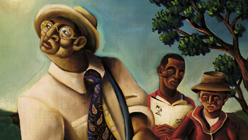The 2013 spring auction season will soon be underway, and during that time, there may be breathless reporting of what sales brought in the most cash for major houses like Sotheby’s and Christies in the United States, Europe, and Asia. For most people, accounts of multi-million dollar sales are what constitute their knowledge of the art market and the transactions that take place behind closed doors in hushed tones. If you visit San Francisco’s own Museum of the African Diaspora (MoAD), you will see a collection of art and historical documents drawn from the history of African Americans and their enslaved predecessors that reflects both the collector’s tastes and sense of stewardship.
The Kinsey Collection: Shared Treasures of Bernard and Shirley Kinsey, Where Art and History Intersect, the cumbersomely titled exhibition currently on view, represents the life’s work thus far of Bernard and Shirley Kinsey. Combining fine art and ephemera amassed over thirty-five years, the collection was founded with Inuit and Native American art and grew with the addition of African American objects. Bernard Kinsey describes the direction and deep dimensionality of the collection as products of the couple’s desire to understand the minute and largely unknown contours of the African American experience — the smells, tastes, daily injustices, and personal victories. A desire to balance the horrors of institutional slavery with the resilience of those who lived through it is apparent within the design and presentation of the exhibition itself, but is nowhere better heard than in the boisterous, well-informed descriptions written by the collectors themselves.
The collection is neatly organized by category in the museum’s third floor gallery, starting with the importation of Africans to European colonies throughout the west. These otherwise mundane financial accounts document some of the earliest shipments of human cargo, and the experience of reading them is breathtaking. A second object in the same vitrine serves as a resilient counterpoint to the notes of injustice. The book Ioannis Leonis Africani Africae (1632) is the earliest geographical account of North Africa by someone born and raised on the continent. I was not familiar with the book’s author, al-Hasan ibn Muhammad al-Wazzan al-Fasi, a Moorish diplomat who was captured and briefly imprisoned in Rome before being presented to and baptized by Pope Leo X. Writing under the name Leo Africanus, his words describe the austere beauty of a region on the verge of colonization.
Photographer unknown, Well to Do Black Couple, c. 1890, Hand-colored tin type. Courtesy of the Kinsey Collection.
The presentation moves deftly through early masterpieces of African American painters including Robert S. Duncanson, Charles Ethan Porter, and Edward Bannister, emphasizing that artistic accomplishment took place despite the presence and perils of slavery. At roughly the midpoint of the exhibition, we are presented with documents that reinforce the chilling terror of life under the lash for the millions of souls who weathered it. If you’re like me, this section of the show includes facts about the nation’s history that are often glossed over in middle school history classes.


